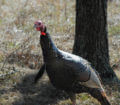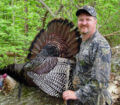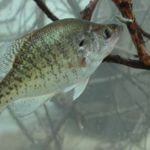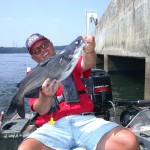John’s Note: One of the nation’s longtime, leading turkey callers and hunters and star of turkey-making hunting videos, Chris Parrish of Centralia, Missouri, has won four World Turkey Calling Championships and five Grand National Turkey Calling Championships and the 2002 World Turkey Calling Championship with Knight and Hale Game Calls (http://www.knightandhale.com/).
 You need several different types of diaphragm calls, such as a raspy call, a high-pitched or a sweet call and a call that falls in-between those two classifications. Make sure you carry some type of friction call. Also take various kinds of strikers for that call because each striker will produce a different sound, which makes the calls sound like various hens speaking with different voices. Too, carry a push-button call and a conventional box call with you. On any given day, a gobbler may come only to one of these calls.
You need several different types of diaphragm calls, such as a raspy call, a high-pitched or a sweet call and a call that falls in-between those two classifications. Make sure you carry some type of friction call. Also take various kinds of strikers for that call because each striker will produce a different sound, which makes the calls sound like various hens speaking with different voices. Too, carry a push-button call and a conventional box call with you. On any given day, a gobbler may come only to one of these calls.
In my turkey vest, I’ll have . . .
* diaphragm calls, including a cutter;
* box calls;
* slate calls;
* strikers;
* push-button calls; and
* tube calls.
Know When To Use Decoys for Turkeys:
I never use decoys when I hunt in the woods. I believe decoys look unnatural in the woods, and in my opinion, they can create a dangerous situation for a hunter. I only use decoys on the edge of fields, on power line right-of-ways or on woods roads where I can see a turkey or a hunter coming from a long way off. I also make sure I have a tree bigger than my shoulders behind me when I set out a decoy. Unless I’m hunting a really-vocal bird, when I use decoys, I’ll give subtle clucks and purrs, to sound like feeding hens. Decoys can be particularly useful when hunting in the West because they can draw in a gobbler from a long distance.
 Carry a Variety of Locator Calls:
Carry a Variety of Locator Calls:
I always carry an owl hooter to call with early in the morning and late in the afternoon and a crow call to use in the late morning and in the middle of the day to locate gobblers. Always use a locator call before you ever give a turkey call. You want to pinpoint a gobbler’s location before you try and call to him. If you start off with hen calls, the gobbler may come in so close to you that he sees you when you try to set-up.
If you can’t get a gobbler to respond to an owl call or a crow call, and you try a turkey call, use either a tube call or a box call. These two calls make higher-pitched and louder sounds than most other turkey calls do that carry further than most other turkey calls will. These calls often will snatch a gobble out of a longbeard and cause him to shock gobble, even if he doesn’t want to talk. Sometimes western hunters use coyote calls to locate turkeys.
Rely On Your Woodsmanship Skills:
Knowing where a turkey wants to go, what a turkey wants to do and how to get in front of a turkey without spooking him will play a more-critical role in your taking a turkey than your calling skills will. When you decide to set-up to bag a bird, look the area over. Make sure no barriers are between you and the turkey. Always get in the best position you possibly can to take a bird, the first time you set-up on the gobbler. You’ll have the best chance of taking a gobbler the first time you set-up to take him. If you set up in the morning, use soft clucks and purrs just to let the turkey know your position. Keep your calling soft and simple.
 Try the Fighting Purr if All Else Fails:
Try the Fighting Purr if All Else Fails:
If you call to the dominant bird in a region with a fighting purr, he’ll come in quickly. If you call to the subordinate bird in an area, he may shy away from this call. Either way, you’ll bring a conclusion to the hunt.
Both world-class turkey hunters Chris Parrish and Walter Parrot agree that turkey hunters need to watch turkeys and listen to them to learn how to call on the day they hunt them.
To learn more about turkey hunting, check out John E. Phillips’ print, Audible, Kindle and Nook turkey books at https://johninthewild.com/books/#turkey and at www.barnesandnoble.com. You also can download a free Kindle app that enables you to read the book on your iPad, computer or SmartPhone.
You can learn more about calling turkeys by going to johninthewild.com/audio-files/ for audio tapes to purchase audio turkey tapes of Lovett Williams, Rob Keck and Chris Kirby, available for download to your SmartPhone, tablet or computer.
For a free copy of John E. Phillips’ “The Turkey Gobbler Getter Manual,” go to https://johninthewild.com/free-books/ to download.
















